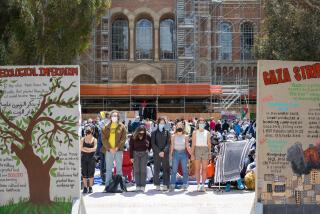Nixon Library Technology Lets Visitors ‘Interview’ Him
- Share via
YORBA LINDA — Stephen Gilroy sat alone in the Presidential Forum room, videotaping the enigmatic figure on the television screen who was explaining how he decided to resign from the presidency of the United States.
When former President Richard M. Nixon was finished, Gilroy clicked off his videocassette recorder and walked out, leaving behind hundreds of questions and answers about a man who had intrigued him for years.
“I would like to spend the whole day in here,” he said.
The 36-year-old American history teacher from Long Island, N.Y., said he is tired of hearing his students, who weren’t even born when the Watergate scandal made the news, call former President Nixon a crook. A desire to educate his students, coupled with what he calls an obsession with Nixon, caused him to travel to Yorba Linda this week to visit the Richard M. Nixon Library and Birthplace.
“I’ve been following him since I was 14,” Gilroy said Friday. “I’m still somewhat obsessed with Richard Nixon. He’s been in the public eye longer than any other American figure, yet he’s still an enigma. You can’t quite figure him out.”
Anyone who is interested can try to figure Nixon out in the site’s Presidential Forum room, where two computers have been set up to let the user ask Nixon any of more than 280 questions, including “In hindsight, do you think Spiro Agnew was the right choice for vice president in 1968?” and “Do you think Vietnam was worth it?” and “Are you sorry for Watergate?”
Topics span Nixon’s life, from his early years through his political career, his presidency, Watergate and his resignation to his personal life after public office.
The two computers look like television screens but respond to a user’s touch. When a person touches a topic, wires in a thin plastic sheet covering the 45-inch screen tell the computer to display questions for that topic.
Developed by Exhibit Technology of New York City, the program instantaneously finds the response to a question on one of 10 laser discs holding more than five hours of video sequences. The responses are each about two minutes long and are displayed in the order they are requested.
The responses take the form of videos of Nixon, either purchased through television networks or taken personally by Exhibit Technology. Sometimes, answers were found to fit the questions; other times, it happened the other way around.
“You find a piece that sounds like an answer, and you formulate a question,” said John Singer, vice president of Exhibit Technology. “Twenty years from now, a 12-year-old kid can come in, and Richard Nixon will talk to him.”
Visitors decades from now will hear the same responses as today. For example, to the question “How did you arrive at the decision to resign from the presidency?” the screen shows a picture of Nixon drafting a speech and airs this response:
“In my usual, methodical way. I put down the pros and cons on the decision in front of me. . . . ‘Resign right now’ was what I didn’t want to do. I’m a fighter. I just didn’t want to quit. Resigning would be an admission of guilt, which it was. . . . (But) I had no choice but to resign.”
And to the question “What do you remember about your final departure from the White House?” Nixon responds this way:
“I turned around (at the door of the helicopter) and there was the crowd as they had been so many times before. . . . Then I gave a salute or a wave, turned around and got in the helicopter. . . . I could hear the engines whirl, and I closed my eyes. I was very tired. As the helicopter began to rise, I heard Mrs. Nixon talking to no one, yet everyone, and she said, ‘It’s so sad. It’s so sad.’ ”
Nixon says that someone gave him a 3-inch-by-5-inch index card with the following couplet from the Ballad of Sir Andrew Martin written on it:
“I am hurt, but I am not slain. I shall lay me down and bleed a while. And I shall rise to fight again.”
“That’s the story of my life,” Nixon says.






